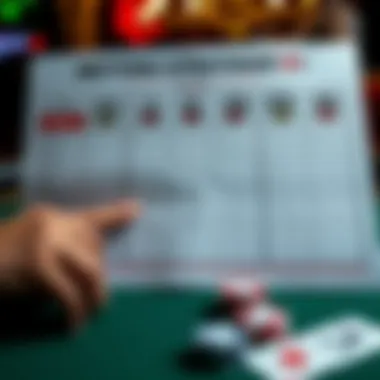Mastering Spanish 21: Rules and Winning Strategies


Intro
Spanish 21 is often regarded as a thrilling spin on the classic game of blackjack. While both games share the same basic premise, Spanish 21 sets itself apart with its unique rules and more favorable odds for the player. The game is rich in history, tracing back to Spanish gambling roots, and its popularity has surged in recent years, especially among casino-goers looking for an exciting alternative to traditional blackjack.
In this article, we will navigate the ins and outs of Spanish 21. From understanding the core rules to diving deeper into advanced strategies that can enhance your chances of winning, we aim to provide you with a comprehensive perspective. We will also touch on the psychological aspects of gameplay and what makes gambling enjoyable while maintaining a responsible attitude towards it.
Let’s embark on this exploration of Spanish 21, shedding light on what makes it a standout option in the world of card games.
Preamble to Spanish
Spanish 21 is a fascinating variant of traditional blackjack that has garnered popularity across various gambling venues, from bustling brick-and-mortar casinos to the expansive online platforms that have taken the gaming world by storm. Understanding this variant can enrich the experience of players, offering them unique ways to engage with the game. What sets Spanish 21 apart isn’t just the removal of certain cards from the deck; it’s the infusion of additional rules and features that can significantly alter gameplay dynamics.
In this section, we take a closer look at what Spanish 21 entails, the compelling reasons for its rise in popularity, and what players stand to gain by learning its ins and outs. The game is more than just a gamble; it’s a blend of strategy, skill, and a bit of luck, making it an ideal choice for those who enjoy the thrill of betting.
Defining Spanish
Spanish 21 is played with a modified deck of cards, specifically, a standard 48-card deck, which means that the 10s are removed from each suit. The removal of these cards adds an intriguing twist to the odds of achieving 21 and necessitates a change in strategy for players used to standard blackjack. The main objective of Spanish 21, much like its more famous counterpart, is to obtain a hand value as close to 21 as possible without exceeding it. However, the rules of Spanish 21 allow for some additional benefits that can provide players with a tactical edge.
One of the standout features is the option to surrender your hand when faced with unfavorable circumstances, reducing potential losses. Additionally, players can double down any number of times and even after splitting pairs, effectively increasing their chances of winning in a single round. This flexibility draws many players who are looking not just for luck but for ways to leverage strategic thought in their betting decisions.
Comparison with Traditional Blackjack
When you compare Spanish 21 to traditional blackjack, the contrast is as clear as day. The most notable difference is the deck composition. With the lack of 10s, the probabilities shift, influencing how players approach bets and strategies. For instance, a player’s chance of hitting an ace is relatively unchanged, but achieving certain hands, like a natural 21, with a lower probability is now a factor.
Moreover, the scoring systems differ subtly; in Spanish 21, a natural 21 beats any other combination of 21, even if achieved with more than two cards. Some might think these elements render Spanish 21 less appealing due to complexities, but many enthusiasts find it refreshingly diverse.
A few key distinctions include:
- Deck Makeup: Spanish 21 uses a 48-card deck without 10s, while traditional blackjack uses a full 52-card deck.
- Surrendering Options: Spanish 21 allows surrendering and specific rules for when this is allowed, not typically found in standard blackjack.
- Bonus Payouts: In Spanish 21, special payouts for certain hands, such as a 21 with five cards or a suited 21, can greatly enhance winnings.
The landscape of Spanish 21 opens up a host of strategic possibilities that shift the gameplay experience, and understanding these nuances is paramount for any serious player.
Historical Context of Spanish
The narrative behind Spanish 21 is as vibrant as the game itself; understanding its roots enhances not only the appreciation of the gameplay but also the strategic layers involved. From its origins to the cultural significance in gambling circles, grappling with the historical aspect of Spanish 21 sheds light on how it evolved into a popular variant of blackjack.
Origins and Development
Spanish 21 has a storied past that intertwines with the rich history of card games in Europe, particularly in Spain. This game emerged as a variant around the 1990s, gaining traction in the casinos of California and subsequently spreading across the globe.
The deck used in Spanish 21 is notably different from that of traditional blackjack. Instead of the standard 52-card deck, Spanish 21 utilizes a 48-card deck. This deck is stripped of the 10s, which adds a unique twist to the gameplay. Players quickly realized that while the absence of tens may seem like a disadvantage, it actually leads to different strategies and opportunities for scoring, thus shaping the play style uniquely.
As this game developed, it garnered favorable comparisons to traditional blackjack, attracting players seeking both a challenge and an engaging experience. The game drew on certain beloved elements of blackjack while introducing exciting new dynamics. Many casinos embraced its popularity by offering diverse tables with various rules, leading to distinct regional adaptations.
Cultural Significance
The cultural resonance of Spanish 21 can be tied to both its geographical origins and its acceptance in gambling culture. In Spain, playing cards have long been a cherished social activity; for many, it’s a celebrated pastime during family gatherings and local festivals. Spanish 21 directly draws inspiration from this cultural environment, transforming a communal activity into a thrilling casino experience.
In the U.S., where gambling laws have relaxed over the decades, Spanish 21 stands out in casinos, often attracting seasoned blackjack players looking for something refreshing. The game embodies the spirit of gambling: it’s not just about the outcome but also the camaraderie and the thrill of shared anticipation among players. This aspect is crucial, as it connects players not only to the game but also to its historical roots.
Additionally, the presence of Spanish 21 in online gambling platforms underlines its growing significance in the digital age. With a plethora of websites adopting this game, it reaffirms the blend of tradition and modernity. Players can now engage with the game from various locations, ensuring its continued relevance and appeal to new generations of gamblers.


"Spanish 21 reflects the ever-evolving landscape of gambling, marrying traditional play with modern strategies in a captivating way."
In essence, exploring the historical context of Spanish 21 not only uncovers its origins and development but also illustrates its place within cultural constructs. The fusion of tradition with a fresh twist keeps players coming back for more, and it promises to retain its allure in the gaming landscape for years to come.
Game Rules of Spanish
Understanding the rules of Spanish 21 is crucial for anyone looking to master this captivating variant of blackjack. It's not just about playing cards; it’s about grasping the unique elements that set this game apart. Unlike traditional blackjack, Spanish 21 allows for more flexibility in gameplay, providing players a better chance at success when they familiarize themselves with its specific rules. Knowing these rules enables players to make informed decisions, which can ultimately swing the odds in their favor. Here, we delve into the essential components of the game that every player should understand.
Understanding the Deck
At the heart of Spanish 21 lies a special deck of 48 cards. What sets it apart is its omission of the 10s from the traditional 52-card deck, which noticeably alters game dynamics.
- Deck Composition: In Spanish 21, players deal with an array of cards consisting of the aces, face cards, and the numbered 2 through 9. This makes the game a bit more complex, as players must strategize around the absence of the 10s.
- Card Values: The value of cards remains consistent with blackjack, where aces can count as either 1 or 11, face cards are valued at 10, and numbered cards maintain their face value.
The impact of the missing 10s is significant; it results in a declination of high-value totals, giving the game a slightly different pace and feel.
Basic Gameplay Mechanics
In Spanish 21, players aim to achieve a hand total closer to 21 than the dealer without going over. Here’s how it unfolds:
- Initial Deal: Players start with two cards while the dealer has one face-up and one face-down card. All players can see the dealer's up card, which is crucial for strategy decisions.
- Player Actions: Similar to blackjack, players have options: they can hit, stand, double down, or split their pairs. The added twist in Spanish 21 is the ability to re-split aces and double down after splitting.
- Special Rules: If they choose to double down, players can draw as many cards as they'd like, making it possible to build strong hands against the dealer.
Mastering these mechanics is vital because they dictate the flow of the game and determine the possible strategies players might engage in.
Winning Conditions
Victory in Spanish 21 hinges on a few key factors:
- Achieving 21: Getting a total of 21 with the initial two-card hand, known as a blackjack, is an automatic win unless the dealer also has blackjack. This is where knowing your odds enhance your game immensely.
- Dealer Busts: If the dealer exceeds 21, all remaining players win, regardless of their hand total. This variant adds a layer of strategy where a player might choose to hold steady with a less than ideal hand, hoping the dealer will falter.
- Bonus Payouts: Additionally, certain hands, like a 21 made up of five or more cards, can result in larger payouts. Understanding these unique winning conditions provides players a competitive edge.
In summary, the rules of Spanish 21 are not just guidelines; they shape the essence of the game. Players equipped with the knowledge of the deck, gameplay mechanics, and winning conditions will undoubtedly find themselves better positioned to enjoy and excel in Spanish 21.
Unique Features of Spanish
In the realm of card games, Spanish 21 carved its niche not only as a variant of blackjack but also through its unique attributes that can significantly alter the gameplay experience. Understanding these features is paramount for both novices and seasoned players hoping to increase their chances of success at the table. The distinct mechanics and rules set Spanish 21 apart from traditional blackjack, making it an enticing option for a wide range of gamblers.
Bonus Payouts
One of the standout aspects of Spanish 21 is the availability of bonus payouts, which can spice up the gameplay considerably. Unlike conventional blackjack, where payouts typically remain consistent, Spanish 21 rewards players with larger bonuses for landing specific hands. For instance, achieving a 21 with five cards results in a 3:2 payout. Additionally, if a player gets a 21 made up of a combination of cards that includes a 10, a face card, and an Ace, the payouts can be even more lucrative. This kind of incentive not only keeps the excitement high but also attracts many players looking to boost their earnings.
"The chance of hitting a bonus in Spanish 21 adds a thrilling edge, enticing players to take calculated risks that might not pay off elsewhere."
However, it's important to note that the specific bonus structures can vary, depending on the house rules of the casino in question. Therefore, players should familiarize themselves with the particular payout system before diving in. This knowledge can be the difference between walking away with a hefty sum or merely covering one's bets.
Rules Variations by Casino
The rules of Spanish 21 aren’t as set in stone as they might appear. Variations can abound from one casino to another, giving rise to a spectrum of gameplay experiences. Some establishments may allow players to double down after splitting cards, while others could impose restrictions that change the strategy players might use.
Additionally, certain casinos may implement different rules regarding the dealer's actions. For example, some might require the dealer to hit on a soft 17, while others will have the dealer stand. These subtle differences can lead to significant impacts on the strategies players choose.
To make the most of Spanish 21, it's best for players to thoroughly check the rules specific to the casino in which they're playing. An army is only as good as its general, right? Well, a player is only as good as their understanding of the rules before the cards are dealt. Here are a few aspects players might encounter:
- Dealer Stands or Hits on Soft 17: This can change the odds in favor of the house or the player.
- Payout structures: Bonus payouts can vary drastically from one venue to another.
- Allowable Splits: Variations on whether players can split cards multiple times can alter strategies.


Strategies for Successful Play
Understanding the nuances of Spanish 21 can make a world of difference when it comes to enjoying this captivating card game. Unlike traditional blackjack, Spanish 21 offers unique opportunities and challenges that require specific strategies for optimal play. By grasping these strategies, players can enhance their chances of winning while navigating the intricacies of the game. This section aims to delve into practical elements that can significantly impact game outcomes, focusing on basic strategy charts, advanced betting strategies, and effective bankroll management.
Basic Strategy Charts
Basic strategy charts serve as valuable tools for both novice and seasoned players. These charts provide a clear guideline on the optimal play based on your hand and the dealer’s upcard. By consistently referring to these charts, players can minimize the house edge and make informed decisions. While memorizing all the details might seem daunting, focusing on the crucial scenarios can be a good starting point.
For instance, a common recommendation is:
- If you have a hand totaling 18 or more, consider standing.
- At 12 to 16, you should vary your approach depending on whether the dealer shows a weak card (like 4, 5, or 6).
- When holding 11 or lower, doubling down tends to be the best bet.
These quick-reference guides can prove essential, especially in a live game environment. As players become accustomed to the charts, thinking on their feet becomes easier.
Advanced Betting Strategies
Moving beyond basic play, advanced betting strategies can also elevate your game. Many players rely on various betting systems, such as the Martingale or Paroli systems, to manage their wagers dynamically. However, it’s crucial to approach these strategies thoughtfully; otherwise, one could end up digging a deeper hole.
- Martingale Strategy: This involves doubling your bet after every loss, banking on the idea that a win will cover the previous losses. Sounds good, right? But be cautious, as it requires a significant bankroll and could risk large sums in a losing streak.
- Paroli Strategy: This strategy turns the tables, focusing on increasing bets after wins, thus protecting your initial stake. This system is generally considered safer but requires discipline to lock in profits.
Each approach has its merits and pitfalls, and it’s advisable to try them out using free online games before hitting the tables in person.
Managing Your Bankroll
Last but not least, effective bankroll management cannot be overstated. Having a clear plan for how much to wager and when can ensure that you’re not just chasing wins while draining your funds. Setting clear limits and sticking to them is paramount.
A few practical tips include:
- Set a Budget: Determine how much you’re willing to lose before you even sit down to play, and don’t exceed that amount.
- Divide Your Bankroll: Split your total budget into smaller session amounts. This way, you can maintain a sense of control over your spending.
- Avoid Chasing Losses: It’s tempting to increase bets to recover losses, but this can lead to a downward spiral. Practice discipline and walk away if things aren’t going your way.
"In gambling, the ball may not always be in your court, but your decisions can surely tilt the odds in your favor."
By combining the guidance from basic strategy charts, leveraging advanced betting systems wisely, and maintaining control over your finances, players can significantly boost their experience while playing Spanish 21. Understanding these strategies is an integral part of becoming a proficient player, setting the foundation for both fun and success.
Psychological Factors in Spanish
Understanding the psychological aspects of playing Spanish 21 can be just as important as mastering the game's rules or strategies. While many players focus on mathematical probabilities and betting strategies, the psychological factors play a significant role in influencing decision-making and ultimately the outcome of the game. Emotions, behavior patterns, and the social environment all intertwine to create a complex web that can affect performance at the tables.
Understanding Player Behavior
Player behavior in Spanish 21 encompasses a wide range of actions, from how players approach the game to how they react to wins and losses. Observing how others play can provide insights into their strategies and risk tolerance. For instance, some players tend to adopt a conservative approach, sticking closely to basic strategy charts, while others might make daring gambles, especially if they feel lucky or are riding a winning streak.
Key behaviors to watch for include:
- Betting patterns: Players may increase their bets after a win, driven by a psychological phenomenon known as the "gambler's fallacy"—the belief that past outcomes influence future results.
- Emotional triggers: Certain events, like a close call with a blackjack or a string of losses, can cause emotional reactions that impact decision-making. For example, a player who just lost a hand may go all-in on the next round, ignoring strategic advice.
- Social influence: Players often adjust their behaviors based on what's happening at the table. Peer pressure or competition can lead to riskier bets or deviating from strategic plans.
By understanding these behavioral nuances, a player can better navigate the psychological landscape of Spanish 21 and adjust their game accordingly.
The Impact of Emotion on Decision-Making
Emotion plays a pivotal role in decision-making while playing Spanish 21, just as it does in various aspects of life. When engaged in a game of chance like this, players often experience a roller coaster of emotions: excitement, frustration, anxiety, and even elation. These feelings can cloud judgment and affect the rational decision-making that’s so crucial in gambling.


Here are ways emotions can influence gameplay:
- Frustration: A player who has faced multiple losses may become frustrated and opt for riskier strategies, abandoning their usual caution.
- Euphoria: Conversely, a player riding a winning wave might become overly confident, leading to larger bets that can quickly evaporate their winnings.
- Anxiety: Nervousness about competition can lead to second-guessing one’s strategy or playing too conservatively, missing out on potential opportunities.
"The mind is like a parachute. It doesn’t work unless it’s open."
Recognizing these emotional triggers and their effects on decision-making is key for players looking to improve their game. Practicing emotional regulation techniques, like mindfulness or breathing exercises, may help maintain a clear head, allowing players to make decisions driven by strategy rather than impulse.
In summary, the psychological factors in Spanish 21 form an essential layer of the gameplay experience. Being aware of these elements can significantly enhance a player’s strategic approach, enabling smarter moves at the table.
Legal and Regulatory Aspects
The world of card games, particularly those involving money, is heavily influenced by legal and regulatory frameworks. Understanding these aspects is crucial for any player engaging in Spanish 21, as they directly affect gameplay, betting, and the overall gaming experience. Spanish 21, like other casino games, operates within a specific legal context that can vary greatly from one jurisdiction to another. This variability presents both opportunities and challenges for players and operators alike.
Gambling Laws Regarding Spanish
Gambling laws regarding Spanish 21 are paramount for players to recognize. Different regions enforce distinct regulations that govern how this card game can be played, whether in casinos or online platforms. For instance, some places may require a gambling license for establishments offering Spanish 21, while others might have looser regulations.
Additionally, regulations can dictate the types of bets allowed, the payout ratios, and the operational hours of gaming establishments. For players, understanding these laws ensures they are gambling legally and responsibly. It also forms a protective barrier against fraudulent practices, ensuring that the games are fair and that their personal information remains secure.
- The legality of Spanish 21 depends on local gambling laws.
- Players should verify the regulations specific to their region before engaging in the game, either online or offline.
- Licensing for casinos can vary; some are strictly regulated while others have fewer controls.
"Ignorance of the law excuses no one." This saying holds true in gambling as well. Not knowing the regulations can lead players into uncomfortable situations.
Online vs. Offline Play Regulations
Online vs. Offline Play Regulations highlight another critical legal aspect in Spanish 21. With the boom in online gaming, different rules apply depending on the platform. Casinos that operate online typically fall under the laws of the country where they are based.
In contrast, brick-and-mortar establishments are subject to the regulations of their local jurisdiction, often adjusted to accommodate offline gambling traditions. This discrepancy can create confusion, especially for those who switch between playing online and in physical casinos. Here are a few points to note:
- Licensing: Online platforms often require specific licenses which may not apply to physical casinos.
- Age Restrictions: Different legal age limits can exist for online versus offline play.
- Promotions and Bonuses: Online casinos may offer promotions that physical establishments cannot match due to their regulatory framework.
Grasping these variations ensures that players remain compliant, reducing the risk of potential legal issues while enhancing their overall enjoyment of Spanish 21. Knowing the rules governing each type of venue can significantly impact one's strategy, helping players make informed and wise decisions.
The Growing Popularity of Spanish
Spanish 21 has carved out a niche in the realm of card games, becoming increasingly popular among gamblers and card players alike. Unlike traditional blackjack, this variant introduces unique aspects that not only attract new players but also keep seasoned gamblers coming back for more. The importance of exploring the growing popularity of Spanish 21 lies in understanding its appeal, the advantages it presents over other games, and the overall impact on gaming establishments. As trends shift and players seek fresh experiences, Spanish 21 stands out for several compelling reasons.
Trends in Casino Offerings
Casinos are keen to adapt to the preferences of their patrons, and with Spanish 21 gaining traction, many establishments are including this game in their offerings. The following points highlight the key trends contributing to its rise:
- Distinct Gameplay: Players are drawn to Spanish 21 because of its unique rules. For instance, certain card combinations yield better payouts, creating excitement and potential for higher rewards.
- Increased Availability: More casinos, particularly in tourist-heavy areas, are seeing the value in offering Spanish 21 tables. The game is now widely available both in-person and online.
- Promotional Events: Casinos often run special tournaments and promotions revolving around Spanish 21, enticing new players to try their hand at this variant.
The End
In the world of card games, Spanish 21 stands out as a captivating and varied twist on the familiar blackjack style. Its growing popularity among gamers isn't simply a fluke; the unique rules, strategic depth, and the thrill that comes with the gameplay have contributed to its rise. Understanding the intricacies of this game bolsters one's approach, transforming casual players into strategic participants who can engage at a deeper level.
Summarizing Key Insights
Throughout this exploration, we've uncovered several key elements that define Spanish 21. First and foremost, the game eliminates the tens from the traditional deck, altering the overall probabilities and strategies involved. This foundational difference can shift the odds in favor of players willing to adapt and learn the new rules. The incorporation of fabulous bonus payouts adds another layer of excitement, providing opportunities for players to reap considerable rewards for skillful play.
Moreover, unlike traditional blackjack, Spanish 21 offers a variety of strategic avenues, including the flexibility in surrendering and splitting. These options allow players to craft an approach tailored to their style, enhancing the gambling experience. The insights into psychological tactics helped paint a clearer picture of how emotions can impact decisions and outcomes, further emphasizing the mental aspect of Spanish 21.
Future Prospects for Spanish
Looking ahead, the future of Spanish 21 appears promising. As casinos continue to innovate their offerings, there's a real potential for Spanish 21 to become a mainstay in both online and brick-and-mortar environments. The increase in skilled players willing to experiment with unconventional strategies will perpetuate a demand for new rule variations and side bets.
The growth of online platforms has also provided a boost, as players are now able to access this exciting variant from the comfort of their homes. With technology advancing at lightning speed, it's possible to envision immersive experiences where virtual reality enhances how players interact with the game.







